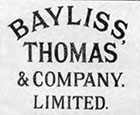
‘Try not the pass!’ The old man said;
‘Dark towers the tempest overhead;
The roaring torrent is deep and wide!’
And loud that clarion voice replied:
‘Excelsior!’
– Henry Wadsworth Longfellow, Excelsior, 1841
The Excelsior name was reasonably common, being used by cycle companies in Guildford, Glasgow and Chicago. But an advert in an 1894 edition of The Irish Cyclist magazine featured a cyclist tackling a hill with a caption replacing the last two lines of Longfellow’s poem, to read:
What need I fear? The voice replied
For you see I ride an Excelsior!
Judging from the note below, from 1890, there appears to have been a tradition of misappropriating Longfellow in The Irish Cyclist:


1898 ‘Excelsior’ Roadster
Maker: Bayliss, Thomas & Co Ltd
25″ Frame
28 x 1 3/4 Wheels
Fixed Wheel
(Now sold)

This rare roadster was previously owned by my friend John’s father, and was in his family for the past 40 years. It’s a quality machine and wonderful to ride.
It’s a rare bicycle, and I’ve not yet found a relevant catalogue to illustrate this model. Comparing it to the adverts reproduced here, it appears similar in profile to both the 1897 and 1900 pictures.
The 1898 advert shows a lightweight racing style machine with a different chainwheel.
The 1899 advert mentions supplying the Post Office with Excelsiors. Such contracts, because they required cheaper ‘trade’ sale prices, were a way for companies to sell off older models. You can tell that this Excelsior is a quality machine by the way it rides; but the design of hubs, gears, brakes and lightness of tubing in the latter half of the 1890s was evolving fast. This machine would have been state-of-the-art for 1896/97 but, within just three years, was already outdated.
The 1900 advert mentions freewheel and brakes on both wheels, but this example has fixed wheel with front plunger brake. Freewheels were introduced in 1898. In the competitive and innovative market place of 1900, a fixed wheel machine with plunger front brake was already old-fashioned, so I think this example is earlier. I’ve assumed Bayliss, Thomas were slow to adopt freewheels, and therefore estimate its year of manufacture as 1898 or 1899 until I find information to the contrary. I think this was the model subsequently sold in bulk to the GPO in 1899 as the Excelsior GPO Light Roadster.




 BAYLISS, THOMAS & Co Ltd
BAYLISS, THOMAS & Co Ltd
Excelsior Works, Lower Ford Street, Coventry

Bayliss, Thomas & Co, established in 1874, were well-known makers of bicycles and tricycles at the Excelsior Works in Lower Ford Street, Coventry. Their first machine, an ordinary, was called the Excelsior (one of several trademarks used by the company). They became Britain’s first motorcycle manufacturer, producing a motor-bicycle in 1896.
The advert below dates from 1907. They stopped making bicycles around 1910 to concentrate on motorcycle production.

The company name Excelsior Motor Cycle Co was registered in 1909. When the company was taken over in 1919, it moved to Kings Road, Tyseley, Birmingham 11.
The name Bayliss, Thomas & Co was still used for exports to avoid confusion with the German and American Excelsior; there was also a Belgian car called the Excelsior.
During WW2 Excelsior supplied the Welbike (below) which, postwar, became the Corgi.

Below is a 1955 Excelsior Autobyk autocycle that I sold a few years ago.

















1998 VCC BAYLISS, THOMAS STUDY GUIDE







The two bicycles mentioned in the above article were sold by Brian Kington at the 2007 Beaulieu Autojumble, to a Dutch enthusiast.
With thanks to Ron Beams for starting the Bayliss Thomas Study Guide; Brian Kington for additional information; and the VCC for making this study guide available. The above interest obviously waned when the above bicycles were sold. I’ll continue researching the Excelsior, and add more to this Bayliss, Thomas archive as my research turns up further information.
***
BAYLISS, THOMAS at the 1910 STANLEY SHOW
Stand No 39
This exhibit will be found one of the most interesting in the show. The Model Grand, which is one of the firm’s leading lines, is a high-class machine, with the best possible equipment – oil bath gear case, specially neat roller lever brakes, Dunlop tyres, and Villiers free wheel. This model is also made in the form of a trussed frame for gentlemen’s use, and has at strut running from the bottom of the head lug to the ends of the chain stays, thus coupling up the two points on which most strain is brought to bear. The specification includes Dunlop tyres, similar brake to the Grand roadster, and 26 in. wheels.
Then there are the Royal models in various types, Excelsior Eureka models, Popular models, and Miniature machines.
This snippet reveals that the Bayliss, Thomas name was still in use at the 1910 Stanley Cycle Show. The company registered the name Excelsior Motor Cycle Co in 1909, so the two company names seem to have been used for a while.













BAYLISS, THOMAS ADVERTS
1897


1898


1899


1900


AMERICAN EXCELSIORS

TO SEE THE
AMERICAN EXCELSIOR
PLEASE CLICK HERE






















































